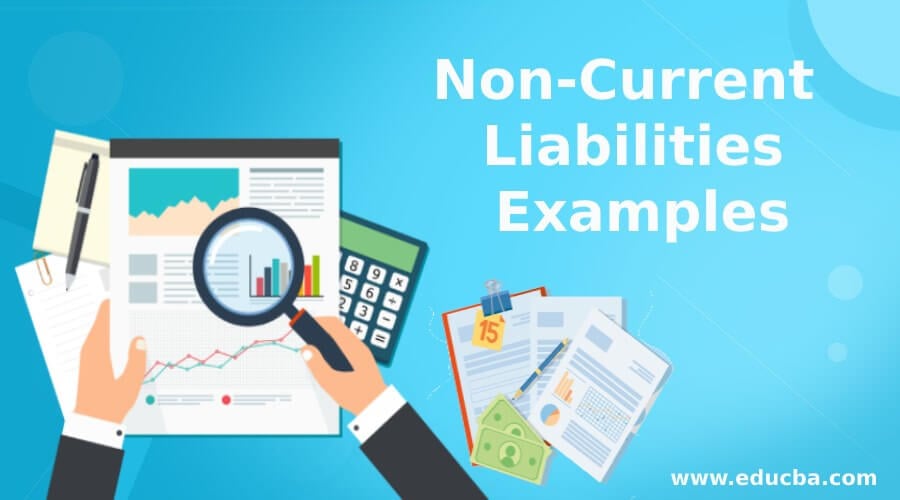Updated July 19, 2023

Definition of Non-Current Liabilities
Non-current liabilities are long-term. The obligation to settle the Liability is beyond 12 months. so if there is any harm that needs to be fulfilled not recently is called non-current Liability.
Non-current liability examples are long-term loans payable, long-term bonds issued, defined pension benefit obligation, life insurance sold, deferred tax liability, long-term lease payment, etc. Let’s look at Non-Current Liabilities Examples in detail.
Explanation
The non-Current liabilities example shows the burden that the company needs to repay in the long term. The examples assist analysts in understanding the liquidity of a company and its future cash requirements. The balance sheet lists Non-Current liabilities in the non-current section of the liability side.
Examples of Non-Current Liabilities
Example #1 – Long Term Loans Payable
Company XYZ expanded its business last Year. The total estimated cost of the expansion was $500,000. The expansion process leads to an increase in sales for the company. Before the development, the company was not so profitable. The State Bank granted Company XYZ a long-term loan, and the company offered to repay $700,000 after five years. So the obligation is to pay off $700,000, which will be triggered after 5 years. Since one year has already elapsed, Company XYZ has four more years to repay the loan. The company will record the loan amount as a long-term liability in its Non-Current Liability segment.
Example #2 – Long Term Bonds Issued
Petrochad is an oil drilling company. Oil drilling setup requires enormous capital investment to extract oil, transport, etc. Capital requirements are often met by issuing bonds in the market. Bonds are legal contracts in which the issuer must pay a predetermined sum on a future date in exchange for a current price. Say that the company Petrochad issued long-term bonds for 10 years. The Bond value is $1,000,000. So at the end of the 10th Year, petrolhead needs to arrange $1,000,000 and pay off the bondholders. So the Liability is fixed, but it is not current. Petrochad will show the Liability in the Non-Current Liability portion of the balance sheet.
Example #3 – Defined Benefit Pension Obligation
Edward runs a medium-sized private company where 500 employees work. The company follows a defined benefit pension scheme. The scheme entails paying employees a fixed pension after their retirement for the rest of their lives. The revised pension amount will depend on the last drawn salary during retirement. So the defined benefit pension plan is a liability for the company. The Liability will be triggered once the employees start to retire. The present value of the future Liability is the actual pension liability that reflects in the books today. Since this is not a current liability, the amount is recorded under the Non-Current segment.
Example #4 – Life Insurance Sold
ABC Ltd is an insurance provider. They provide insurance coverage for life, houses, cars, etc. Life Insurance is protection that pays a lump sum when the protection buyer dies. So the claim that can be triggered due to death must be paid by the company. The average life expectancy varies from country to country. The Liability that may arise due to the end is a futuristic event. This is an example of Non-Current liability, where the Liability will occur. ABC Ltd will estimate the potential insurance claims and show them under the non-current segment of the Liability side.
Example #5 – Deferred Tax Liability
Deferred Tax occurs when the Tax calculated as per tax authority differs from the Tax calculated by the company. PFG, a manufacturing company, hired an accounting firm to calculate its taxes. The accounting firm followed accounting standards and calculated the tax amount. The tax authority calculated a different amount than the accounting firm had calculated for the Tax. The difference leads to Deferred Tax Liability. If the Liability is not settled within 12 years, the discrepancy will gradually reverse. So as the Liability is long-term, the amount will reflect under the Non-Current side of the Liability.
Example #6 – Long Term Lease Payment
The UFG shipping company operates in the transportation industry. They have a business model in which they don’t buy ships. All the vessels that operate are leased by the company. The leases are of long-term use. The company typically hires ships for 20 years. As the leases are capital leases, the Liability to pay the lease payment is also long-term. In the books of UFG shipping, the lease amount will reflect under Non-Current Liability. Leases are generally for very long periods.
Conclusion
The liability section of the balance sheet shows Non-Current liabilities. If an analyst is reading the books of a company, then the analyst should be cautious while evaluating the Non-Current Liabilities. If a Non-Current liability is huge, the company should plan ways to pay it when it arises—non-Current liability analysis help in judging the liquidity of a company. Too much Non-Current Liability will disrupt the smooth functioning of the business in the future. Several occasions have shown that companies have gone bankrupt due to pressure from Non-Current liabilities.
Recommended Articles
We hope that this EDUCBA information on “Non-Current Liabilities Examples” was beneficial to you. You can view EDUCBA’s recommended articles for more information.


